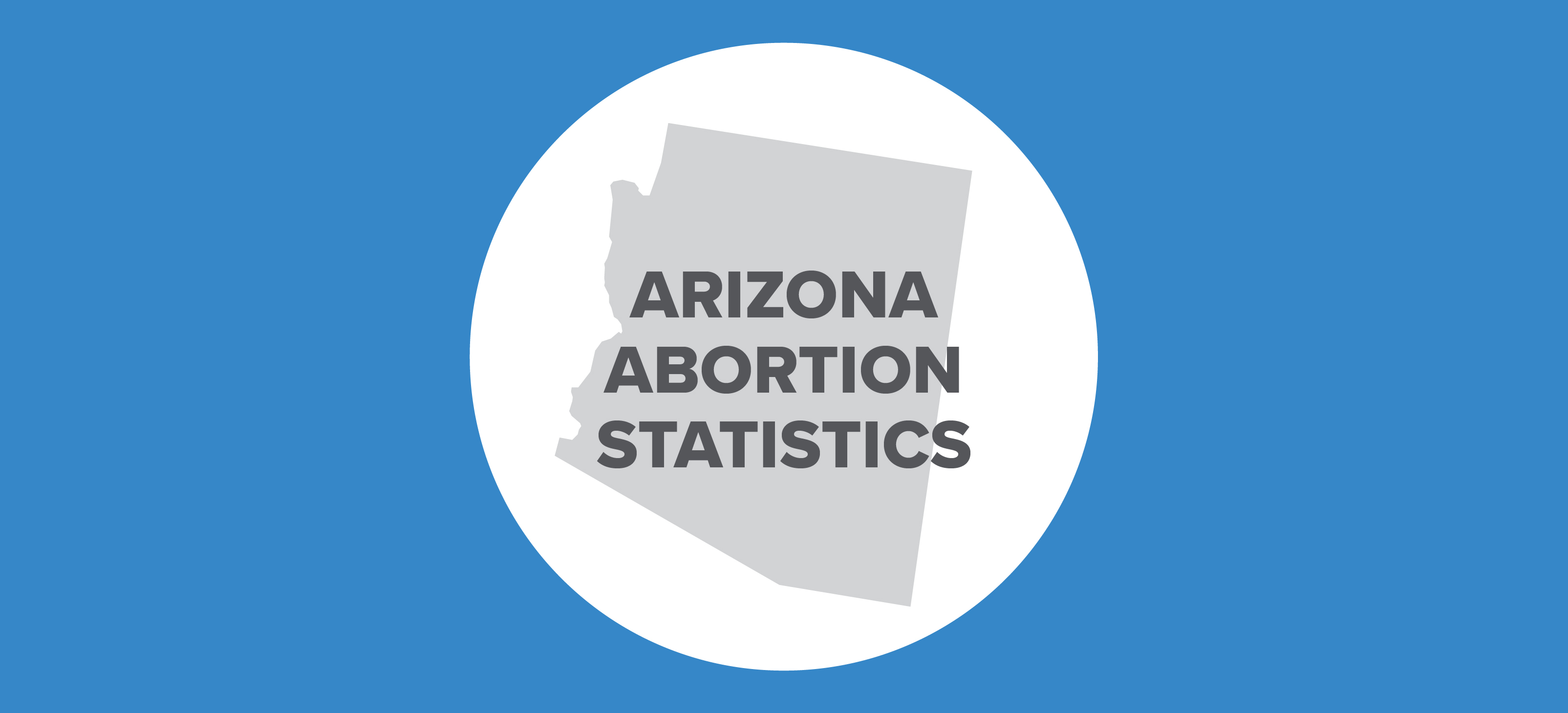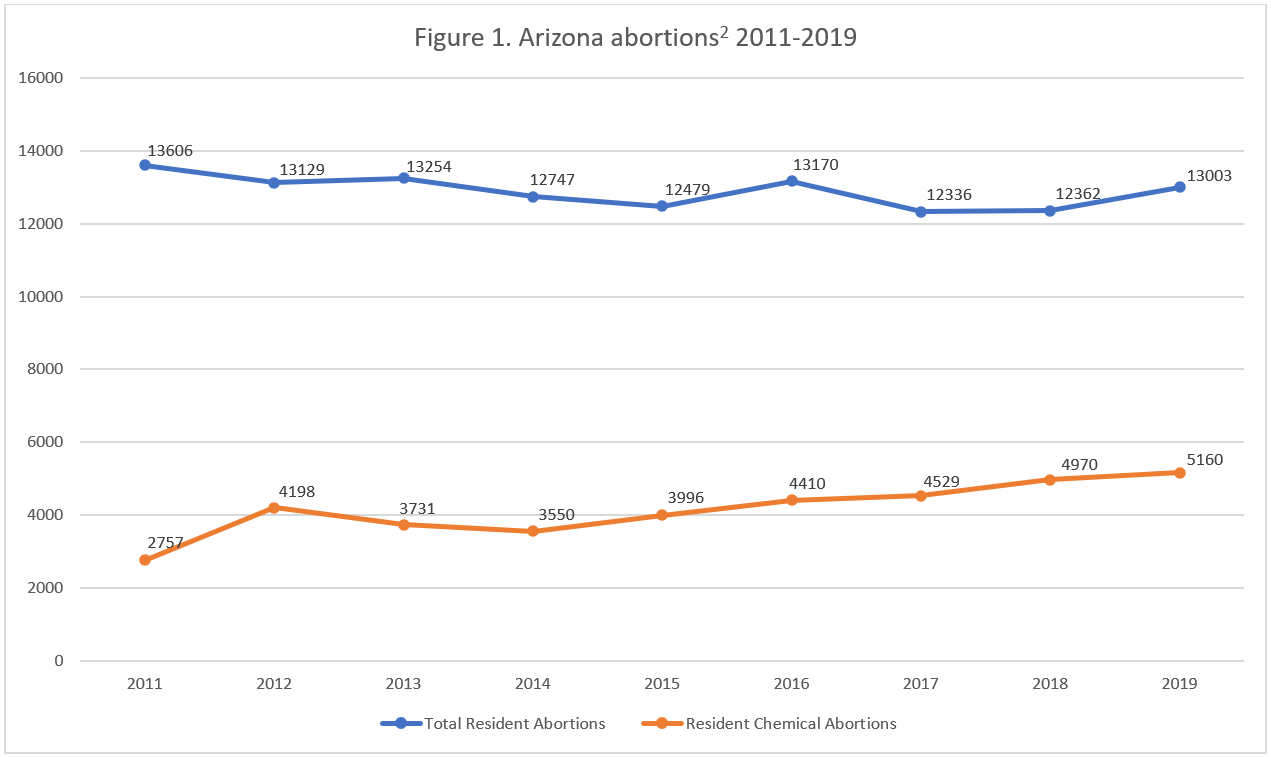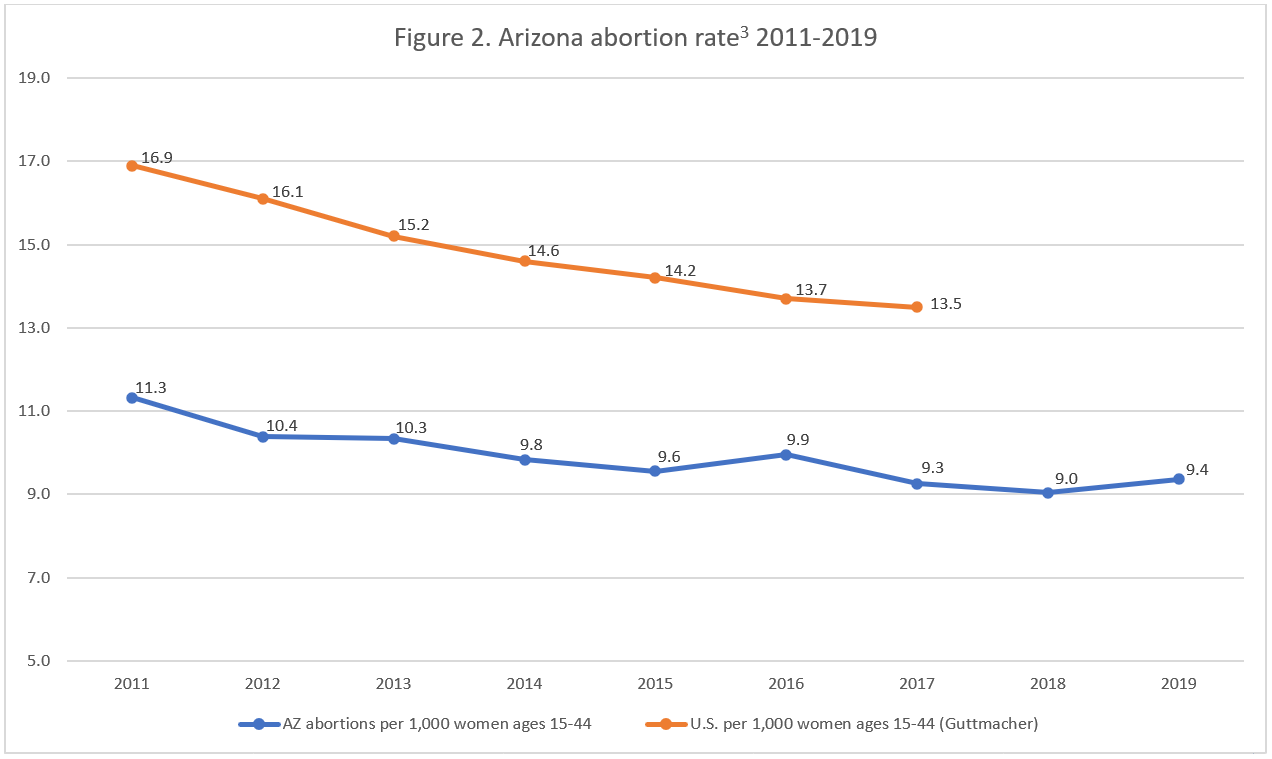Abortion Reporting: Arizona (2019)

Arizona’s 2019 abortion report was published online by the Arizona Department of Health Services in October 2020. The report is the first to be published since Arizona revised its abortion reporting standards in 2018.
Statistics and Changes in Arizona Abortions, 2018-2019

The change in total abortions and chemical abortions reflects abortions performed on Arizona residents. The change in the abortion rate reflects all abortions reported in Arizona, including nonresidents.
Abortion Totals and Trends
In 2019, there were 13,097 abortions reported in Arizona, five percent higher than the total reported the previous year. Chemical abortions performed on Arizona residents increased by a slightly lower percentage, rising four percent between 2018 and 2019 (Fig. 1). Chemical abortions composed 40 percent of Arizona resident abortions in 2019. The Charlotte Lozier Institute (CLI) estimates that Arizona’s abortion rate increased by four percent to 9.4 abortions per 1,000 women ages 15 to 44 (Fig. 2).
State Report Summary
Demographics
Almost all the abortions reported in Arizona in 2019 (13,003 of 13,097) were performed on state residents, and most of the information in the report is for Arizona residents only. More than half the abortions performed on Arizona women, 58 percent, were performed on women in their twenties. Thirty percent were on women in their thirties, and four percent were on women age 40 or older. Nine percent of the abortions were on girls under the age of 20, including two percent on girls under the age of 18. Arizona requires parental consent before an abortion may be performed on a minor girl. In 2019, 35 girls filed petitions for judicial waivers to the parental consent requirement, and all 35 petitions were granted.
In 2019, Hispanic women made up the racial group undergoing the most abortions in Arizona at 39 percent of the total, followed closely by non-Hispanic white women at 37 percent. Eleven percent were performed on African American women, and five percent were on women of Asian or Pacific Islander ancestry. Three percent were on American Indian or Alaska Native women, a larger proportion than in many other states. Two percent of the abortions were performed on women of multiple races, and four percent were on women whose race was not reported. Arizona reports that African American women had the highest abortion rate at 18.0 abortions per 1,000 women ages 15 to 44, while American Indian or Alaska Native women had the lowest at 5.1.
The majority of Arizona abortions (86 percent) were performed on unmarried women, while just 14 percent were on married women. Nine percent of the abortions were on women with fewer than 12 years of education. Twenty-two percent of the women who obtained abortions had 12 years of education, and another 22 percent had 13 to 16 years. Four percent of the abortions were on women with 17 years of education or more. However, educational status was not reported for 44 percent of the women getting abortions in Arizona.
Thirty percent of the women undergoing abortions reported no previous pregnancies. Forty-three percent reported no prior live births, 65 percent had no previous abortions, and 80 percent had never had a miscarriage. In contrast, 21 percent had one previous live birth and 34 percent had two or more. Twenty-three percent had one prior abortion, and 11 percent had more than one. Eighteen percent had previously suffered a miscarriage. Overall, a fifth of the abortions reported in Arizona were performed on women with one previous pregnancy, 48 percent were on women with two or more prior pregnancies, and two percent were on women whose pregnancy history was not reported.
Medical Information
Sixty percent of the abortions reported in Arizona were surgical procedures, and 40 percent were chemical. Twenty-nine percent were performed at six weeks of gestation. Thirty-five percent occurred between seven and eight weeks of gestation and 17 percent between nine and 10 weeks. Eight percent of the abortions performed on Arizona residents were reported from 11 to 12 weeks of gestation, and six percent occurred from 13 to 15 weeks, dropping to three percent between 16 and 19 weeks. Two percent (242 abortions) were reported at 20 weeks of gestation or later.
For the first time, Arizona published women’s reasons for choosing abortion. Women could select more than one reason, and the report indicated that women’s answers could be conflicting: For 1,010 abortions, the women both selected a reason and indicated that they declined to specify a reason. Still, the report shows that overwhelmingly, abortions were elective (84 percent), while in contrast, just 1.4 percent were performed for maternal health or medical considerations and 1.2 percent for fetal health or medical considerations. There were 24 abortions performed because the mother was a victim of sexual assault and 33 because the mother was a victim of domestic violence. For 15 percent of the abortions, the woman provided another reason, and for 19 percent, it was reported the woman declined to share a reason.
Additionally, the report shares the number of abortions performed for maternal or fetal medical conditions. The annual report does not indicate how these conditions overlapped with the abortions for which maternal and fetal considerations were the stated reasons. In 2019, there were approximately 160 maternal medical conditions and 110 fetal medical conditions given as reasons for abortions.
Arizona reports the share of abortions performed in each type of abortion facility in the state. The vast majority of the abortions performed on Arizona residents, 97 percent, occurred in abortion clinics. Fifty abortions were performed in hospitals, 39 as inpatient procedures and 11 on an outpatient basis. Five abortions were performed as outpatient procedures at other facilities. The type of facility was not reported for two percent of the abortions. However, it is likely that all abortions for which type of facility was not reported occurred in abortion clinics. When the percentages by type of facility are calculated by summing the number of abortions reported by each individual facility, the percentage reported by licensed abortion clinics is over 99 percent.
Arizona requires doctors to report their specialties; four abortions were performed by doctors who reported more than one specialty. Eighty percent were performed by doctors who specialized in obstetrics and gynecology, and 18 percent were performed by general family practitioners. One abortion was reported by a doctor who specialized in emergency medicine, and two were performed by doctors with other specialties. The doctor’s specialty was not reported for two percent of the abortions.
Twenty-one percent of the women and six percent of the unborn babies were given anesthesia in advance of the abortion, while 77 percent of the women and 92 percent of the unborn babies were not administered anesthesia. Anesthesia was not reported for two percent of the abortions. Arizona requires abortion facilities to report the method of disposition of the bodies of unborn babies killed by abortion, and for the vast majority of abortions (99 percent) “tissue was not donated in part or whole”. Less than one percent were delivered to a mortuary to be buried or cremated, and fewer than six of the unborn babies were donated to a person or establishment, although the exact number is suppressed to meet Arizona’s guidelines for reporting small numbers.
In 2019, the Arizona Health Care Cost Containment System, Arizona’s state Medicaid program, reported two abortions. However, neither of these abortions was paid for using state funds. It is possible that these abortions met the requirements for federal funding, which pays for abortions in cases of rape, incest, or risk to the life of the mother.
2019 marked the first reporting year since Arizona’s amendments to its abortion complication reporting requirements went into effect.1 Previously, Arizona collected information on complications reported subsequent to the abortion procedure using a complication reporting form. In 2018, Arizona added space to the abortion procedure report form for doctors to report complications occurring during the abortion. In 2019, there were 15 reports of complications at the time of the abortion procedure, of which the most frequent was heavy bleeding, reported in eight cases. There were also 28 reports of subsequent complications, of which 26 were unique and not duplicates of the 15 immediate complications. The report does not specify what these subsequent complications were.
Beginning in 2019, Arizona also implemented a requirement for doctors and other medical professionals to submit a monthly informed consent report to the Arizona Department of Health Services. This form is separate from the abortion procedure reporting form, and both doctors who perform abortions and doctors who refer for abortions are required to report. Arizona requires that each woman give informed consent and be provided with the opportunity to view the ultrasound and listen to her baby’s heartbeat before an abortion is performed. In 2019, 11,230 women were provided with the informed consent information, and 11,269 were offered the opportunity to see the ultrasound and listen to the heartbeat. No medical emergencies resulting in exceptions to the informed consent requirement were reported. The report does not indicate why the number of women provided with the informed consent information was lower than the total number of abortions performed on Arizona residents in 2019.
In 2019, there were 15 embryos or fetuses reported to have been born alive during abortions. The report does not state what happened to these babies.
Arizona Abortion Centers
For the first time, Arizona’s abortion report includes the number of abortions reported by each facility in the state. Eighteen facilities reported abortions in 2019 – nine hospitals, one doctor’s office, and eight abortion clinics. The vast majority of abortions performed on Arizona residents (99.6 percent) occurred in facilities that were licensed as abortion clinics. The two highest-volume abortion centers were Camelback Family Planning and Family Planning Associates Medical Group, each of which performed 21 percent of the total. However, Planned Parenthood’s four abortion centers together accounted for 45 percent of the abortions performed on Arizona residents. Eight percent of the abortions were performed at Acacia Women’s Center, and five percent were reported by Desert Star Family Planning. The number of abortions performed at other types of facilities (the nine hospitals and the doctor’s office) was suppressed.
State Ranking
In CLI’s 2016 survey of abortion reporting across in the country, Arizona was identified as one of the best reporting states, tying for third place. In the four years since then, Arizona has continually worked to improve its reporting. In this latest round of improvements, Arizona began collecting and reporting additional complication data, women’s reasons for choosing abortion, the use of anesthesia during abortion procedures, information on abortion facilities and doctors, the informed consent process, and whether any public funds were used for abortion. To continue to strengthen its reporting, Arizona could ensure that all complications are reported by reminding or surveying emergency rooms, urgent care clinics, and other medical facilities of the reporting requirement. Additionally, the state could report information on the outcomes of babies born alive during abortions.


- Statistics on abortion complications reported here represent a minimal number of deaths and complications. As such, this data cannot be used to calculate either an accurate abortion mortality rate or an accurate abortion complication rate for the state.
- 2011 was the first full year of reporting after Arizona’s law requiring abortions to be reported went into effect.
- Rates were calculated by CLI using population estimates from the United States Census Bureau. The rates were calculated using the following formula: (abortions performed on Arizona residents ÷ number of resident women ages 15-44) x 1,000. Rates may differ slightly from previous CLI articles due to revised population estimates.





























